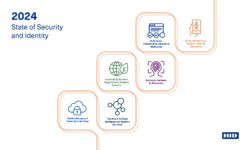5 Fastest Nations to Adopt Facial Recognition and AI
No longer relegated to science fiction movies and novels, facial recognition is being applied in numerous vertical markets and use cases.

The global market for facial recognition cameras and software will be worth an estimated $7.8 billion, predicts Markets and Markets. No longer relegated to science fiction movies and novels, the technology is being applied in numerous vertical markets, from helping banks identify customers to enabling governments to identify criminals.
Abishur Prakash, a geopolitical futurist and author, examined the top five countries where facial recognition cameras and algorithms are taking off the fastest for a recent article in Robotics Business Review. Following is an abridged look at his report, which includes examples of use cases from each country.
CHINA
China leads the world in deploying facial recognition. It has 170 million video surveillance cameras, with another 400 million expected in the next three years. Many of these cameras have artificial intelligence (AI) and facial recognition. In 2017, China filed for more than 900 facial recognition patents, compared with the 96 patents filed in the U.S.
Police in Nanchang used facial recognition cameras to identify a criminal alongside 50,000 other concertgoers. Meanwhile, in a railway station in Hanan province, police officers are using smart glasses with facial recognition to catch criminals.
Facial recognition is also automating police work. If people jaywalk in Shenzhen, facial recognition could catch them and display their faces and names on an LED billboard to “name and shame” them. They are also sent a text with their fines.
UNITED ARAB EMIRATES
The United Arab Emirates (UAE) is a global leader in the adoption of new technologies, and facial recognition is no exception.
For instance, the UAE is testing AI for border control. At the Dubai Airport, a virtual aquarium is fitted with 80 facial recognition cameras that scan people as they walk through the aquarium. The system then either clears them for entry into the country or alerts security personnel.
Related to this is a plan to automate immigration officers in the UAE by 2020 by using AI and facial recognition to decide who can enter the country.
The UAE is also looking to facial recognition to improve safety. In preparation for Expo 2020, police in Dubai will deploy tens of thousands of facial recognition cameras to identify criminals as part of a project called “Oyoon.”
But these cameras won’t just capture and analyze footage. They will also send out “verbal warnings” to people to stop them from doing something.
JAPAN
Like China, Japan is deploying facial recognition across the board.
For the 2020 Tokyo Olympics, facial recognition cameras will be used to allow athletes and media to enter venues. About 300,000 to 400,000 people will have their faces approved. The goal is to boost security by not relying on ID cards, which can be forged or duplicated.
Sleepy workers could be jolted into awareness in future offices, thanks to a test of facial recognition cameras and surveillance. If workers are caught sleeping on the job, they could be blasted with cold air.
Japanese airports are another venue for facial recognition. Japan’s Ministry of Justice plan to deploy the technology to all major airports next year. It will scan foreigners before they leave Japan, speeding departures, and allow airports to send more staffers to the arrivals part of the airport.
Unlike other countries, Japan is applying facial recognition to address societal challenges, like gambling addiction. Japanese casinos are exploring advanced facial recognition cameras that can tell how many times a person has entered a casino.
SINGAPORE
Singapore is often described as the high-tech capital of Asia. And this image is being bolstered by the use of facial recognition in creative ways.
For example, the Singaporean government is leading a project called Lamppost-as-a-Platform (LaaP). Through LaaP, all 110,000 lampposts in Singapore will be fitted with cameras connected to facial recognition software. The government said it wants to use LaaP to improve security and reduce terrorism.
One of the companies bidding is Yitu Technology, a Chinese firm that also supplied facial recognition cameras to a police force in Malaysia. Singapore is also looking at using facial recognition to find elderly people who are lost in the city, something which is already active in China.
Meanwhile Singapore’s Changi Airport is testing facial recognition cameras to spot travelers who are late or lost. Already Changi Airport’s T4 terminal is using facial recognition to allow passengers to check in on their own, including immigration and boarding.
UNITED STATES
While the U.S. has the potential to deploy facial recognition at the same scale as China, adoption of the technology has been slow. However, things may be changing now. As of 2016, almost 50% of all adults in the U.S. were in facial recognition databases operated by police stations.
American airports are increasingly turning to facial recognition. The U.S. Customs and Border Protection agency has been experimenting with facial recognition cameras at 13 airports.
Following the experiment, Orlando International Airport was selected as the first airport in the country to use facial recognition to scan all international visitors. It takes less than 2 seconds to analyze a face and the system has 99% accuracy.
At the same time, a program called “Biometric Exit,” which tracks people with visas leaving the U.S. through facial recognition could be deployed at airports across the country. The federal government is also planning to use facial recognition at border crossings with Mexico to scan people and vehicles.
If you enjoyed this article and want to receive more valuable industry content like this, click here to sign up for our FREE digital newsletters!

Security Is Our Business, Too
For professionals who recommend, buy and install all types of electronic security equipment, a free subscription to Commercial Integrator + Security Sales & Integration is like having a consultant on call. You’ll find an ideal balance of technology and business coverage, with installation tips and techniques for products and updates on how to add to your bottom line.
A FREE subscription to the top resource for security and integration industry will prove to be invaluable.













